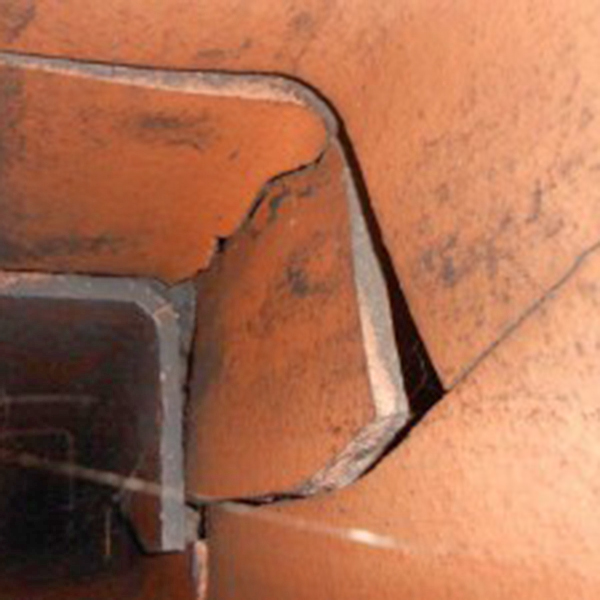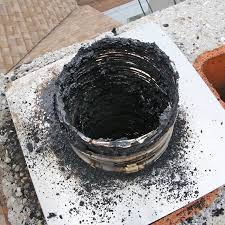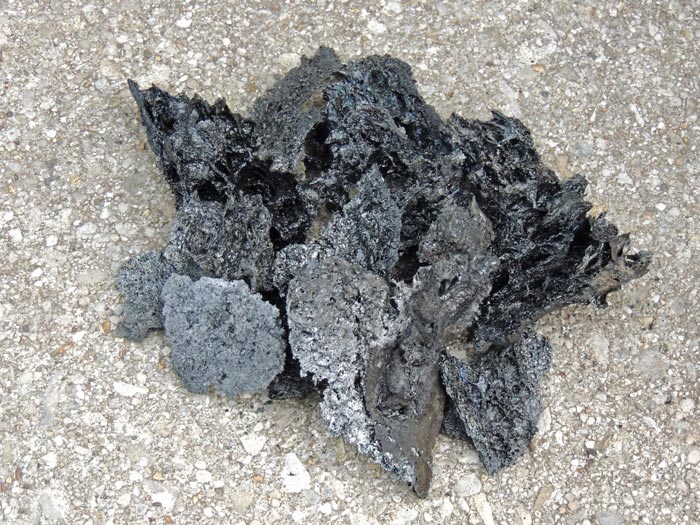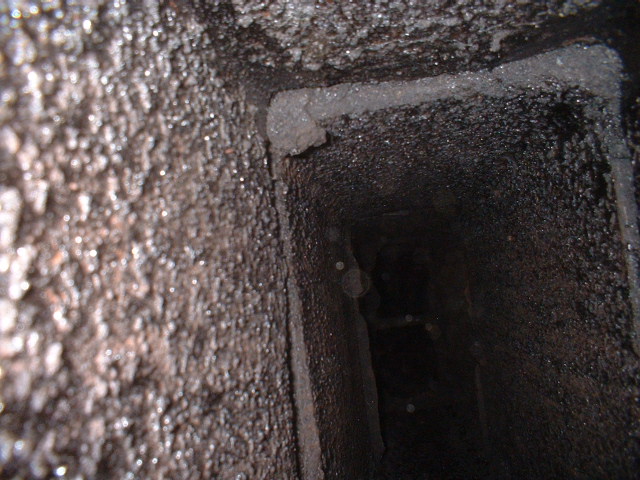FAQ
1) Check the gas fireplace for operation (gas flow, ignition, etc).
2) Remove the front glass and set it aside.
3) Remove any ceramic or cement logs and set aside.
4) Vacuum pilot light and re-test it.
5) Clean inside of firebox of any dust, cobwebs or other debris.
6) Clean the glass with water or cleaning solution as applicable.
7) Remove any dust from the gasket (as applicable).
8) Clean any fans, converters, blowers, and compartments that may be part of the unit.
9) Reassemble glass doors and the front of the unit.
10) Go to the roof and check the cap, pipe and look for any water intrusion.
11) Type report with observations and present report and invoice to customer.

No matter whether your chimney vents a fireplace, wood stove or furnace, it likely contains a section of terra cotta flue tiles linked together to form the chimney lining.
This flue liner should be well sealed to protect the efficiency and soundness of your chimney. But over time and usage, problems and defects can develop that threaten the safety of your chimney. Cracked flue tiles are one of the most common problems homeowners deal with.
Cracked flue tiles
Cracked tiles frequently occur when the heat is not evenly distributed throughout the chimney. This causes the tiles to expand in an uneven fashion and the result can be cracking, buckling or splitting. Terra cotta tiles are most likely to have this problem because the material does not quickly absorb heat.
Flue tiles can also crack due to sudden events such as a chimney fire, earthquake or even lightning strike. Inferior craftsmanship of the chimney, or even the ongoing settling of your home, can also cause cracked flue tiles.
Finally, exposure to corrosive chemicals and moisture can cause pieces of the flue liner to delaminate. This process is known as spalling.
Why cracked flue tiles are dangerous
Cracked flue tiles can lead to gas leakage that allows carbon monoxide to seep into your homes interior.
Combustible creosote or soot can escape through the openings in the cracks and gaps and build up outside of the flue liner. If the creosote catches fire in your chimney, very serious damage to your home can occur because the fire will no longer be restricted to the flue.
Pieces of flue tile that break off due to spalling can then form dangerous blockages within your chimney.
Loss of chimney efficiency
The defects caused by cracked flue tiles, gaps, and spalling can begin a process that not only threatens your family’s wellbeing, it can begin destroying your chimney from the inside out.
In order to work efficiently, chimneys must be free of gaps and cracks so that gases cant escape. Chimneys are like straws. If a straw has a crack or hole in it, liquid wont flow through it properly.
Cracks and gaps allow extra air into your chimney. They also slow the flow of smoke and gases rising up and out. As a result, your fireplace, wood stove or furnace will diminish in heat-efficiency.
How to fix cracked chimney tiles
The terra cotta flue tiles themselves cannot be repaired due to the expansion and contraction properties that occur in a flue when burning fires. The expansion stress will cause any repair to crack again.
The best way to fix cracked tiles is by lining or relining the chimney itself.
Typically, the preferred option for a chimney liner is a stainless steel liner. Stainless steel comes with a lifetime warranty and usually never needs replacing.
Another alternative is removing the chimney stack and rebuilding it with new terra cotta flue tiles, but this is a more costly route.
If you have concerns about cracked flue tiles, don’t hesitate to reach out to Chimney Clean Company.
Creosote is a sticky, highly flammable substance that is a natural byproduct of chimney smoke. Creosote builds up inside of chimneys over time.
What Does Creosote Buildup In a Chimney Look Like (Stages Of Creosote)
Stage 1 Creosote Buildup
Stage 1 creosote buildup is flaky and powdery and is similar in appearance to coffee grounds. This is the normal stage of creosote buildup. It is flammable and therefore it is important to regularly remove it from your chimney. When the temperature gets hot enough while burning a fire, gasses release from the burning wood and condense on the cold surfaces of your chimney, resulting in the creosote buildup.
Stage 2 Creosote Buildup
The second stage of creosote buildup is characterized by a high concentration of thick tar and is highly flammable. This level of buildup significantly increases your risk of a chimney fire.
Stage 3 Creosote Buildup
This is the last and most dangerous stage of creosote buildup and it is not removable. At this point, the creosote is hard and shiny and can easily ignite, leading to a chimney fire. You should hire a professional to remove the normal creosote before it gets to this point.
What Are The Risks Of Creosote Buildup In The Flue?
As explained earlier, normal creosote buildup is flammable but it can be cleaned by a professional. However, if the creosote reaches Stage 2 or 3, it becomes a serious fire hazard.
The Solutions for Creosote Buildup
Prevention: Regular annual cleaning of your chimney can prevent the build up of creosote before it becomes a serious fire hazard.
Frequent Cleaning: If your chimney has already reached Stage 2 or Stage 3 creosote build up and you use your fireplace several times per week during the cold weather, it is advisable to either cease use of the chimney or to have it frequently cleaned. This could be done at the start of the burning season and mid the burning season to ensure your chimney does not accumulate more flammable creosote.
Install a New Liner in the Chimney: Some homeowners choose to have the chimney relined with a stainless steel liner and this is a surefire way of reducing fire risk.
Install a Gas Insert with Liner: A common solution for a chimney that is unusable due to creosote buildup is to install a gas insert into the fireplace. These units have their own liners and can be a safe solution for homeowners who have Stage 3 Creosote buildup.
Chemical Cleaning: Chemicals can be used to decrease the creosote buildup and it does help but its not a surefire method for handling creosote build up and frequent cleanings would still be required to keep it safe. The chemical process usually takes about 3 hours to apply, then it sits for 2 weeks and is swept. After this process, frequent cleanings will be required to keep it from building up again.
The Bay Area, has a program in place, called no burn days. These are days on which Bay Area residents are being told not to burn fireplaces or wood stoves. There is a lot of misinformation about this subject. Sometimes customers tell us they wont let us burn our fireplaces any more. This is not correct. There are only certain days of the year when it is considered necessary to restrict burning of wood. The no burn days are declared differently each year.
Heres the list for the past 10 years:
2022 9 no burn days
2021 16 no burn days
2020 52 no burn days
2019 26 no burn days
2018 13 no burn days
2017 18 no burn days
2016 27 no burn days
2015 9 no burn days
2014 10 no burn days
2013 6 no burn days
You can access spare the air day alerts at this link: https://www.sparetheair.org/
So, while alerts do occur, there are still many more days when you can enjoy your fireplace with a wood fire, than days when you cannot.
Some customers tell us that they are converting their fireplace to a gas-log set. This is a set of logs made of concrete or other material which burns gas instead of wood. There are some drawbacks here. First, when gas logs are installed in an open fireplace, the installer is REQUIRED to clamp the damper wide open. This means that, when you are not using the fireplace, you cannot close the damper to keep the cold air from coming in! This causes a tremendous amount of lost furnace heat going straight up the flue when you are not using the fireplace. In addition, gas log sets are pretty inefficient and dont often provide much heat to the residence. Lastly, natural gas is a fossil fuel, the burning of which may contribute to increasing carbon dioxide levels and global warming. (Burning wood does not create a net increase in carbon dioxide, but does add to the particulate matter in the air.).
Lets compare this to a gas insert. This is a closed, glass sealed unit that has logs or stones inside, it is quite efficient, provides a great deal of heat to the residence, operates with a remote control, and has a blower to get even more heat into the residence. The fireplace is sealed behind it, so no cold air comes in even when the unit is not being used. (We sell and install this type of insert.) It still adds to the carbon dioxide level of the atmosphere, but this burning is much more efficient. Lets face it, if youre going to burn fossil fuels, you shoul ddo it in a way that actually gets the most amount of useable heat into your residence!
Wood is a renewable resource that doesnt add to the carbon dioxide levels of the air, and burning it is not a problem if you follow the no burn days. Gas is a non-renewable fossil fuel. If you decide to burn it instead of wood and you are concerned about the quality of our air, it is very important that you get actual heat out of it by burning it in a gas insert or gas stove rather than a gas log set.
We hope this information serves to help you make use of your existing fireplace and make educated choices should you decide to convert your fireplace to a gas insert or log set.
How often should my chimney be cleaned? It is recommended that chimneys be inspected once a year by a professional chimney sweep and cleaned if needed.
I have heard many “rules of thumb” that can help gauge how dirty a chimney probably is. Some are:
- If you burn every day in the winter, sweep every year; if you burn every other day, sweep every other year, and so on.
- Sweep after every two cords of oak firewood (every cord for a wood burning stove or insert).
- Sweep every 200 fires (every 100 fires for a wood burning stove or insert).
Really, while these rules of thumb might help you have a feel for how dirty your chimney is, the correct rule is given above: inspect once a year by a professional chimney sweep and clean if needed.
There are many types of wood, but most wood does not make good firewood. Some is too hard to light, or too hard to keep burning, or too smoky, etc.
In this area of the country, there are only a few woods that make good firewood.
- Oak – This is by far the most common wood used here. Oak makes a hot fire, is not too difficult to start, and gives off pretty good heat
- Madrone – This is a smooth wood that is easier to start than oak. It is often mixed in with oak when a customer orders firewood.
- Almond – This is a pretty good wood for fires. It burns hot and is usually less expensive than oak.
There are some woods that are used as firewood by some customers, but which are not recommended.
- Eucalyptus – This is a very oily wood that burns very hot and leaves little ash. The problem is that it leaves a coating on the inside of the chimney which is almost impossible to remove. It is just like third stage creosote, hard and shiny. I always recommend that customers avoid eucalyptus.
- Redwood – This usually comes from fences or decks that have been torn down. Same as eucalyptus, leaves a residue that cannot be removed. You should have that old deck hauled away.
Then there are several woods that fall in between. These are pine, spruce and fir. These are soft woods, very easy to light, but give relatively little heat per log. I tell customers it’s OK to use these as long as they are well seasoned, and as long as the chimney is swept often.
Sometimes customers tell me about a tree or even a bush that was growing in their yard, and ask if they should stack it up for firewood. The answer is almost always no; they will put a lot of work into the project and be very disappointed when their house fills up with smoke!
All firewood needs to be seasoned before it will burn well. This means that it is stacked where it will remain dry for a period of time to allow some of the natural moisture to evaporate. The wood should sit for at least 6 months, preferably a year. Wet wood is very smoky and hard to keep burning.
The best way to tell if wood is seasoned is to lift a log. If it feels wet and heavy, it needs more seasoning. You can develop a feeling for this characteristic of wood.
Many customers burn pre-made logs, like Presto logs or Duraflame logs. I have found that these are alright to burn in an open fireplace, but that they sometimes make a chemical odor that some people don’t like. The chimney still needs to be cleaned regularly. One of these logs makes about as much buildup as a regular, 3 log oak fire. These pre-made logs can sometimes be burned in a wood stove or insert, but not if there is a catalytic re-burner in the stove.
When we clean your chimney and fireplace, we also look for any areas in the system that could represent possible dangers to you and your family.
In the Bay Area, we still find many chimneys that were damaged by the Loma Prieta earthquake in 1989. We check the structural integrity of your chimney for any cracks, loose mortar or bricks, or flashing that might leak water.
We also check your chimney system from top to bottom for cracked flue tiles, areas that show damage from water penetration or general wear and tear, correct damper function, or any other points that might make your chimney unsafe to use.
Your chimney sweep then writes up a report for you that lists any problems that were found so that you will have a permanent record of the condition of your chimney and fireplace.
Our sweeps are also trained to do repairs, and make recommendations on how you can get more use and satisfaction from your fireplace. Be sure to ask any questions you have while the sweep is there; we are only too happy to help you learn as much as possible about your fireplace!
A chimney cap is a black or silver manufactured box that sits on top of your chimney. It has four major purposes:
- It prevents sparks and burning debris from getting out of your chimney onto the roof or surrounding areas. Chimney caps are sometimes called “spark arresters”.
- It keeps rain from entering your chimney. Water is very destructive to the inside of your chimney. It mixes with the creosote inside your chimney, which eats away at the mortar inside. Also, rain causes the metal parts inside your fireplace, such as the damper, to rust. A chimney cap acts like an umbrella on top of your chimney to keep out the rain.
- It keeps out birds, squirrels and other animals.
- It keeps out leaves and branches.
Chimney Clean Company sells and installs a chimney cap made by a company called Chimney Products Inc. This premium cap comes in coated steel or stainless steel, and has a warranty from the manufacturer. We have installed over 10,000 chimney caps in the Bay Area!
Every city in the Bay Area now has an ordinance that requires a spark arrester on a chimney before it is used. These ordinances were passed to ensure safe operation of our chimneys for both the homeowner and his or her neighbors.
The damper is the metal door located just above the firebox. Its purpose is to prevent cold air from entering your home when you AREN’T having a fire.
When you ARE having a fire, you want to ensure that your damper opens FULLY. This is one of the points that we check as part of our inspection. Dampers that do not fully open often cause smoke to come back into your house when you make a fire. In fact, along with needing a cleaning, faulty dampers are one of the major causes of smoking back.
Sometimes, particularly when there is no chimney cap on top to keep out the rain, your damper can become so rusted that it no longer operates. The handle of your damper can even rust off! Also, some older houses were built without dampers in the fireplace.
In these cases, we can install a “top damper”. This is a spring-loaded plate that fits inside a standard chimney cap on top of your chimney. A fire-proof cable hangs down from this damper plate, through the chimney and into your firebox below. We attach a small bracket to the side wall of your firebox, and you open and close the damper by pulling and latching this cable.
This type of damper works even better than a “standard” damper does. It can be set up to seal very tightly, and it is quite easy to operate. You can even tell whether it is open or closed just by looking at the handle, without even touching it!
1) We lay a clean tarp down in front of your fireplace, and lay a runner from your fireplace to the nearest door.
2) We carefully tape a cover over the opening of your fireplace to prevent dust from entering your home.
3) We then tape a second, larger cover over the first for extra protection.
4) Next we go onto your roof with fiberglass poles and special brushes. These brushes are designed to match the shape and size of your flue, so that all the areas inside the chimney are scraped clean of creosote buildup. After finishing with the brushes, we place a fan on top of your chimney, so any dust generated later will be pulled up and out.
5) Once finished on your roof, we come back inside your home. At this point we put on a head-to-toe suit called a soot suit, and a respirator.
6) Wearing this protection, we can now sit right inside your firebox. This allows us to clean every surface inside your fireplace. In addition, we can fully inspect the area inside for problems such as missing mortar or dangerous cracks. At Chimney Clean Company, we believe that this is the ONLY way to fully clean and inspect your fireplace! In addition, we can now thoroughly vacuum the space BEHIND your damper, which is where a lot of creosote usually builds up.
7) Lastly, we clean your firebox fully with the vacuum. Then we finish a thorough inspection of the condition of your chimney, and fill out a written report for you.
8) FINISHED! And no mess is made in the room
GUARANTEED!
Nearly every day one or more customers will tell us, “I have a gas fireplace. I don’t need my chimney cleaned anymore”.
While it’s totally true that a gas fireplace does not create a creosote build up in the chimney, it’s also NOT true that it doesn’t need to be cleaned and inspected.
Gas fireplaces and gas fireplace inserts have their own annual cleaning actions that must be done. And the chimneys do need to stay free of cobwebs and critters. Gas lines need to be checked and gas log sets need to be cleaned and properly positioned so they are not in the direct line of fire. Gas media sometimes needs to be replaced after many years of burning.
The glass for gas inserts should be regularly cleaned to avoid getting a filmy build up on the glass that cannot be removed.
Frequency of such maintenance is usually included in the manuals for the gas insert or gas fireplace.
A typical statement in the manual usually reads like this one from the Kozy Heat, Chaska 34 manual:
ATTENTION: Installation and repair should only done by a qualified service person. The appliance should be inspected before use and at least annually by a professional service person. More frequent cleaning might be required due to excessive lint from carpeting, bedding material, et cetera. It is imperative that control compartments, burners, and circulating air passageways of the appliance be kept clean. Use a vacuum to clean all components.
Regular maintenance can help prevent against the need for repairs caused by dirty components.
A gas fireplace or insert that is properly maintained can bring warmth and convenience to your home.
As qualified technicians we can help you with your gas fireplace and insert maintenance needs.
